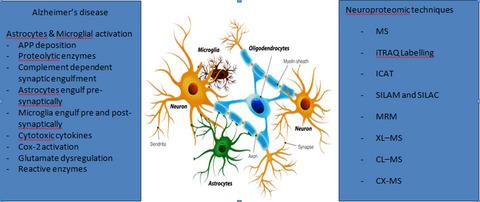当前位置:
X-MOL 学术
›
Eur. J. Neurosci.
›
论文详情
Our official English website, www.x-mol.net, welcomes your
feedback! (Note: you will need to create a separate account there.)
Neuron‐glia interactions: Molecular basis of alzheimer’s disease and applications of neuroproteomics
European Journal of Neuroscience ( IF 2.7 ) Pub Date : 2020-05-28 , DOI: 10.1111/ejn.14838 Abdallah Mohammad Ibrahim 1 , Faheem Hyder Pottoo 2 , Ekta Singh Dahiya 3 , Firdos Alam Khan 4 , J. B. Senthil Kumar 5
European Journal of Neuroscience ( IF 2.7 ) Pub Date : 2020-05-28 , DOI: 10.1111/ejn.14838 Abdallah Mohammad Ibrahim 1 , Faheem Hyder Pottoo 2 , Ekta Singh Dahiya 3 , Firdos Alam Khan 4 , J. B. Senthil Kumar 5
Affiliation

|
Neurodegenerative disorders present with progressive and irreversible degeneration of the neurons. Alzheimer's disease (AD) is one of the most common neurodegenerative disorders affecting 50 million people worldwide (2017), expected to be doubled every 20 years. Primarily affected by age, AD is the cause for old‐age dementia, progressive memory loss, dysfunctional thoughts, confusion, cognitive impairment and personality changes. Neuroglia formerly understood as “glue” of the brain neurons consists of macroglia (astrocytes and oligodendrocyte), microglia and progenitors NG2‐glia, and constitute a large fraction of the mammalian brain. The primary functions of glial cells are to provide neurons with metabolic and structural support in the healthy brain; however, they attain a “reactive” state from the “resting” state upon challenged with a pathological insult such as a neurodegenerative cascade. Failure or defects in their homoeostatic functions (i.e. concentration of ions, neurotransmitters) ultimately jeopardize neurons with excitotoxicity and oxidative stress. Moreover, the most common clinical outcome of AD is the cognitive impairment and memory loss, which are attributed mainly by the accumulation of Aβ. Failure of glial cells to remove the Aβ toxic proteins accelerates the AD progression. The rapidly emerging proteomic techniques such as mass spectrometry (MS), cross‐linking mass spectrometry, hydrogen deuterium trade mass spectrometry, protein foot printing and 2‐DGE combined with LC–MS/MS present wide array of possibilities for the identification of differentially expressed proteins in AD.
中文翻译:

神经胶质细胞相互作用:阿尔茨海默氏病的分子基础和神经蛋白质组学的应用
神经退行性疾病表现为神经元进行性和不可逆性变性。阿尔茨海默氏病(AD)是最常见的神经退行性疾病之一,在全球范围内影响着5000万人(2017年),预计每20年将增加一倍。AD主要受年龄的影响,是导致老年痴呆症,进行性记忆力减退,思维障碍,精神错乱,认知障碍和人格改变的原因。神经胶质细胞以前被理解为大脑神经元的“胶水”,由巨胶质细胞(星形胶质细胞和少突胶质细胞),小胶质细胞和NG2-神经胶质祖细胞组成,构成了哺乳动物大脑的很大一部分。胶质细胞的主要功能是为神经元提供健康大脑中的代谢和结构支持。然而,当受到诸如神经退行性级联之类的病理损伤的挑战时,它们从“静止”状态达到“反应”状态。它们的恒静态功能的失败或缺陷(即离子,神经递质的浓度)最终会损害神经元的兴奋性毒性和氧化应激。此外,AD最常见的临床结局是认知障碍和记忆力减退,这主要归因于Aβ的积累。胶质细胞未能去除Aβ毒性蛋白会加速AD进展。迅速出现的蛋白质组学技术,例如质谱(MS),交联质谱,氢氘贸易质谱,蛋白质足印和2-DGE与LC-MS / MS结合,为鉴定差异表达提供了广泛的可能性AD中的蛋白质。
更新日期:2020-07-17
中文翻译:

神经胶质细胞相互作用:阿尔茨海默氏病的分子基础和神经蛋白质组学的应用
神经退行性疾病表现为神经元进行性和不可逆性变性。阿尔茨海默氏病(AD)是最常见的神经退行性疾病之一,在全球范围内影响着5000万人(2017年),预计每20年将增加一倍。AD主要受年龄的影响,是导致老年痴呆症,进行性记忆力减退,思维障碍,精神错乱,认知障碍和人格改变的原因。神经胶质细胞以前被理解为大脑神经元的“胶水”,由巨胶质细胞(星形胶质细胞和少突胶质细胞),小胶质细胞和NG2-神经胶质祖细胞组成,构成了哺乳动物大脑的很大一部分。胶质细胞的主要功能是为神经元提供健康大脑中的代谢和结构支持。然而,当受到诸如神经退行性级联之类的病理损伤的挑战时,它们从“静止”状态达到“反应”状态。它们的恒静态功能的失败或缺陷(即离子,神经递质的浓度)最终会损害神经元的兴奋性毒性和氧化应激。此外,AD最常见的临床结局是认知障碍和记忆力减退,这主要归因于Aβ的积累。胶质细胞未能去除Aβ毒性蛋白会加速AD进展。迅速出现的蛋白质组学技术,例如质谱(MS),交联质谱,氢氘贸易质谱,蛋白质足印和2-DGE与LC-MS / MS结合,为鉴定差异表达提供了广泛的可能性AD中的蛋白质。











































 京公网安备 11010802027423号
京公网安备 11010802027423号